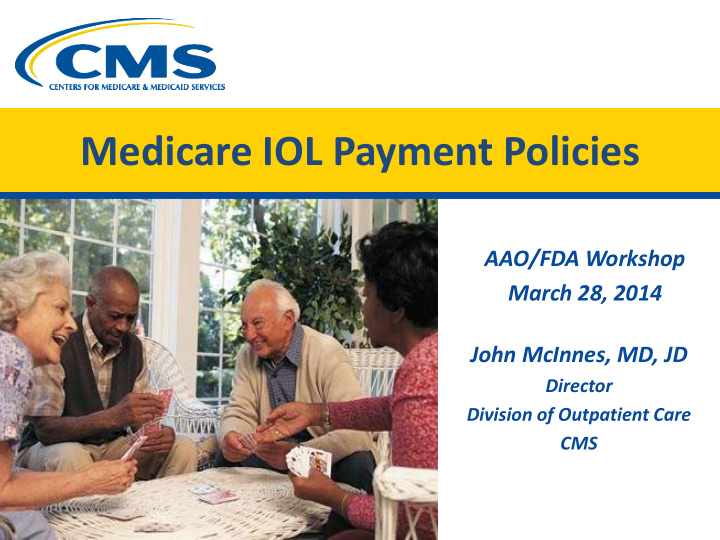



Medicare IOL Payment Policies AAO/FDA Workshop March 28, 2014 John McInnes, MD, JD Director Division of Outpatient Care CMS
Disclosures No Financial Relationships to Disclose
Disclaimer • This presentation was prepared by Dr. McInnes in his personal capacity. The opinions expressed in this presentation are his own and do not reflect the view of the Centers for Medicare & Medicaid Services, the Department of Health and Human Services, or the US government.
Topics • Medicare Payment for IOLs – Default Payment Policy – Presbyopia-Correcting (PC) and Astigmatism- Correcting (AC) IOLs – New Technology IOLs (NTIOLs)
Default IOL Payment Policy • Payment for IOL included in overall facility payment for cataract surgery procedure: – 2014 OPPS Payment = $1,766 – 2014 ASC Payment = $976
PC/AC IOL • 2005 Presbyopia-Correcting IOL (PC-IOL) Ruling • 2007 Astigmatism-Correcting IOL (AC-IOL) Ruling • Part of the overall service is a Medicare covered benefit and part not a Medicare covered benefit Covered part – “conventional cataract surgery” – Medicare pays Noncovered part – “presbyopia correcting surgery” and “astigmatism correcting surgery” – Patient pays • PC-IOL = “corrects presbyopia” and provides relief from reading glasses • AC-IOL = corrects astigmatism and provides relief from astigmatic correction
NTIOL • 20 year old statutory provision (1994) • $50 separate payment for every NTIOL for 5 years • 3 classes since 1999 – Astigmatism-Correcting – Multifocal – Reduced Spherical Aberration • Revised NTIOL Regulations at 42 CFR 416.195 in 2013
NTIOL • NTIOL Criteria: – (1) The IOL is approved by the FDA. – (2) The IOL shall have a new lens characteristic in comparison to currently available IOLs. The labeling, which must be approved by FDA, shall contain a claim of a specific clinical benefit imparted by the new lens characteristic. – (3) The IOL is not described by an active or expired class of new technology IOLs; that is, it does not share a predominant, class- defining characteristic associated with improved clinical outcomes with members of an active or expired class. – (4) Any specific clinical benefit referred to in paragraph (a)(2) of this section must be supported by evidence that demonstrates that the IOL results in a measurable, clinically meaningful, improved outcome. Improved outcomes include:
NTIOL • Improved outcomes include: – (i) Reduced risk of intraoperative or postoperative complication or trauma; – (ii) Accelerated postoperative recovery; – (iii) Reduced induced astigmatism; – (iv) Improved postoperative visual acuity; – (v) More stable postoperative vision; – (vi) Other comparable clinical advantages.
NTIOL • Additional points: – EDOF IOLs as NTIOLs? If they can obtain “a claim of a specific clinical benefit” that results in an “improved outcome” for the beneficiary. Benefit/outcome possibly evaluated by validated visual function measurement tools. • NTIOL timing: – 5-year clock starts with first IOL to establish NTIOL category – Claim can be established after initial IOL approval
Thank you john.mcinnes@cms.hhs.gov
Recommend
More recommend